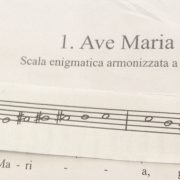The Infamous Scala Enigmatica
A scala cromatica (chromatic scale) can sometimes be a nightmare to practise – and we say so as singers ourselves – but wait till you meet the Scala Enigmatica!
The scala enigmatica, as its name already suggests, is an unusual musical scale featuring both major, minor and augmented seconds. Invented by Adolfo Crescentini, a professor of music at the Bologna Conservatory, this enigmatic scale was first published in Ricordi’s “Gazzetta musicale di Milano” in 1888 as a challenge for its readers to harmonize it. The exact number of submissions to the music journal remains a mystery, and this scale would probably have long been forgotten had Verdi not presented his solution to the musical puzzle in 1889.
The enigmatic scale – or, in Verdi’s own words, “that awkward scale” – was used as the cantus firmus of his Ave Maria, which subsequently became the first song of his Quattro pezzi sacri, notwithstanding the composer’s reluctance in allowing the piece to be published, by reason of it merely being a “game” and hence, “not true music” and should “never [see] the light of day”. But be that as it may, we should probably be thankful that the work had eventually been published, for the austere and bold harmonization for four-part a cappella chorus, as well as the ethereal effect it creates, serve not only as a glorification of Mother Mary, but also as evidence of Verdi’s splendid compositional artistry.
Come hear us perform Verdi’s Ave Maria – plus, of course, the other three pieces – from his Quattro pezzi sacri, and Rossini’s Stabat Mater, in our next concert. Tickets now available at urbtix outlets or online at http://bit.ly/1SARXnH
Event page: https://www.facebook.com/events/364342063776645/



